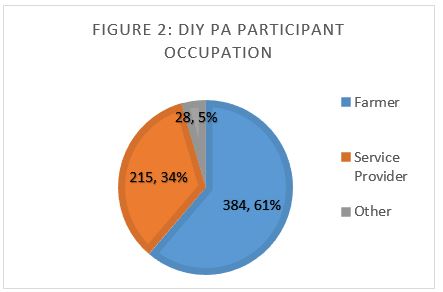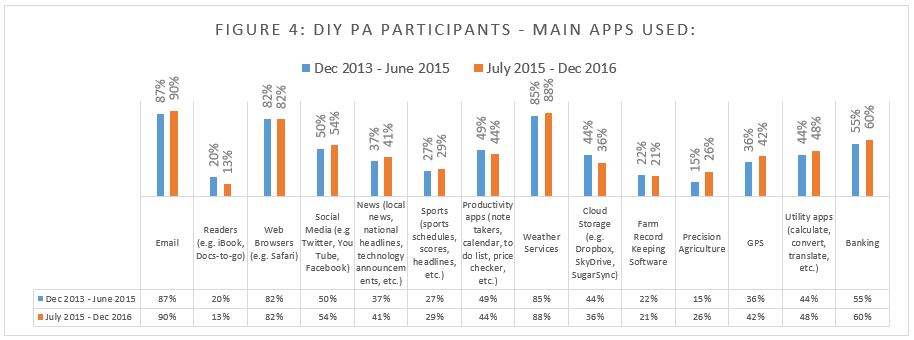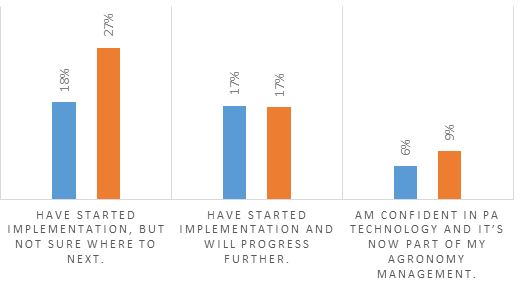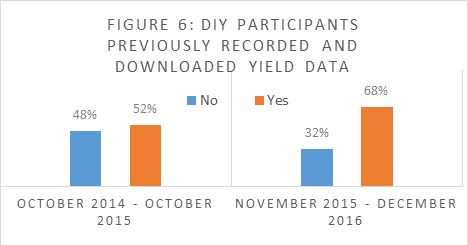DIY Precision Agriculture – what we learnt
Author: Nigel Metz, South East Premium Wheat Growers Association (SEPWA) and Alice Butler (SEPWA) | Date: 27 Feb 2017
Key messages
- The direct economic gains from Precision Agriculture (PA) technologies are often unclear. Do It Yourself PA (DIY PA) helped with a basic understanding which started people on the road to adoption.
- Low yield mapping literacy has not helped adoption as there is not a means to measure potential PA benefits. DIY PA courses directly addressed this and noted improvement in the second half of the projects delivery.
- Previous experience of disjointed difficult software has tarnished the adoption reputation of PA. This project shifted some of this perception however there is still some way to go.
- The need for PA support specialists is growing rapidly. Industry has yet address how PA skills can be developed amongst industry professionals. The most logical path to this is the fostering of young farmers and service providers in PA skills for eventual wide scale industry adoption.
- Good internet connection is required to ensure a smooth experience in PA adoption. Slow connections with limited data cause apprehension to try new technologies.
Aims
This GRDC funded project was a “hands on” integration of mobile device technologies and low cost simple PA methods for grain growers and agronomists. The project aimed to deliver technology skills training to regional industry people with the overall goal of creating a local peer to peer ripple effect in assisting PA adoption.
Method
SEPWA was contracted by GRDC to train 120 growers and 30 consultants per year for three years in the basics of Precision Agriculture (PA). As this was a state-wide project, SEPWA relied on local grower groups to coordinate and promote the course to growers and local service providers.
On the day workshops were delivered by two to three presenters and participant numbers ranged from eight to 20. Workshops ran from approximately 9am to 4pm and course content changed depending on location and what the participants were interested in, however the following items were generally covered;
- Mapping basics of points, lines polygons in google earth, GPS accuracy and map projections,
- How to read data cards into PA software.
- Creating yield maps and zone maps, exporting to google earth and accessing for use out in the paddock.
- Converting yield/zone/mud map to prescription map and assign product rates,
- Dropping soil test points on yield maps. Navigate to points outside. Import soil test results into PA software.
- Discussion of other topics such as CTF integration and the day concluded with a discussion on new apps.
SEPWA was careful to alter course content depending on course participants. This was done via a “round the room” introduction and requests from course participants. This enabled participants’ to “own” content and direct the days learning objectives.
Results
DIY Precision Agriculture (DIY PA) began in December 2013 and in three years delivered a total of 67 courses to 656 participants within regional Western Australia (WA).
Participants were asked to complete an online survey at the beginning of each course and this data has given SEPWA an understanding of the demographic who have participated in DIY PA. Of the 656 participants trained, 627 participants completed the online survey, with 61% of those aged between 25 and 45.

Figure 1. Age of participants who attended a DIY PA workshop over the projects three-year lifetime.

Figure 2. Occupation of participants who attended a DIY PA workshop.
Of those 627 participants 61% were farmers (384/627), 34% were service providers (215/627) which included consultants and researchers, and 5% were other made up of predominately students (28/627).

Figure 3. Tablet/mobile device brand owned by DIY PA participants.
The Apple iPad had clear majority of the market with 78% of our participant sample. There was an increase in percentage of Apple iPad owners within the second half of the project, contrary to the Apple iPhone. While the percentage that don’t own an iPad decreased.

Figure 4. The main apps used by DIY PA participants in the first half of the project compared to the second half.
Email, Web browsing and weather dominate the main apps for mobile device use. Over the progress of the project there was an 11% increase in use of precision Agriculture apps and a 6% increase in GPS apps



Figure 5. Where DIY PA participants were currently at with PA in the first half of the project compared to the second half.
The project noted a consistent reduction of 5 to 6% in the number of people who have “not started” and those who “have explored but not yet implemented” PA. This as well as a 9% increase of the people who “have implemented but not sure where to next” indicates the DIY PA project increased knowledge of PA but by no means has delivered full adoption at an industry wide level.

Figure 6. Percentage of DIY PA participants who had previously recorded and downloaded yield data compared over survey lifetime (Oct 2014 – Oct 2015 compared to Nov 2015 – Dec 2016).
The solid increase of more than double (32% to 68%) of people using yield data was a very positive outcome of the DIY PA project.
Conclusion
DIY PA has exposed a great number of growers and service providers to some of the basics of PA via the delivery of the DIY PA project. This insight into PA provided participants with an understanding as to whether PA fits within their business and if so, allowed them to make a calculated decision as to how they were going to implement it.
SEPWA was pleased to see progress overall in yield data literacy and general PA skills over the duration of the projects delivery. There was however noted a multitude of barriers to adoption throughout the life of DIY PA. The most prevalent including: the time poor status of growers and service providers to upskill; lack of support in regional areas; and less than satisfactory internet connection.
Growers indicated that a key factor preventing them from using PA technology is their time poor status. Farm business-makeup influences available time to upskill, those who do put time into developing their PA skills need support, especially in the beginning. Yet, there are very few farm service providers with PA skills to support these growers and generally support was only found in the larger regional centres, such as Esperance and Geraldton.
PA is a specific skill set that needs to be coupled with agronomy knowledge, therefore it makes sense to be a service provided by agronomists. However, merchandise agronomists do not have a business model that accommodates PA. Their common business model operates primarily through supporting the sales of farm inputs such as fertiliser and pesticides. To provide a PA service they must look at charging themselves out at an hourly basis and this is foreign to their current customer relationship.
There is a chicken and egg type scenario for much of the agriculture support industry, either they have not worked out how to incorporate PA into their business or it’s not their core business and so they can’t prioritise time to develop their skills. This has resulted in agronomists being slow to develop their PA skill set.
Compounding the issue in regional WA is the current telecommunication situation. Internet access is a major issue is regional Western Australia, specifically for grain growing businesses. These businesses are expected to use the same online tools and services that those in urban areas use, however they have significantly lower data allowances at a fraction of the speed and 10-fold of the cost.
Although there are major benefits to adopting PA technologies, time, support, and internet issues make learning PA difficult. Improvements in these areas along with good computer literacy will play an integral role in increasing adoption and innovation in PA.
Acknowledgments
SEPWA would like to thank all the regional grower groups, research organisations and consultants who participated in the DIY PA project.
GRDC Project Code: SEP00012,
Was this page helpful?
YOUR FEEDBACK
